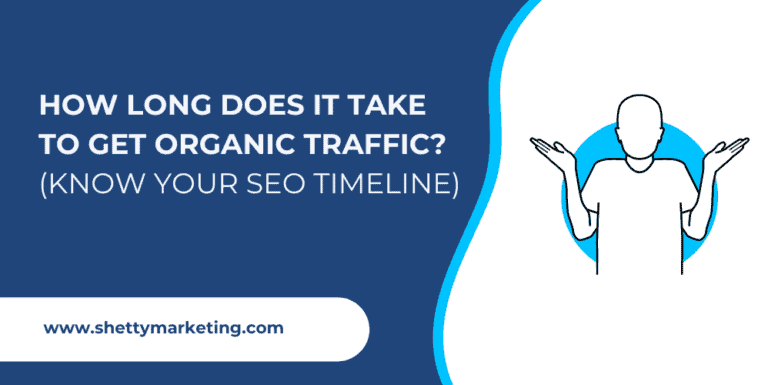I’ll call a spade a spade.
It takes you almost a year or two to get good organic traffic to your new website with a new domain. But if you are churning out content and creating product pages on an already established website, then it can take you around six months. Given that, in both cases, it’s SEO-optimized,
Here’s the thing: Google is the godfather who makes the rules in organic search. Everyone knows that.
So, it decides when your website is worth ranking on the first page of Google.
If you are new to SEO, you are probably imagining a bunch of geeks at Google headquarters sitting down and venting on each website for months together.
But in reality, it’s the untamable beast of an algorithm of Google that decides which webpage makes it to the first search results page.
So, time isn’t the major factor here because algorithms are pretty fast, and they should be quick in deciding which web page takes the sweet spot.
So, what exactly is the deciding factor? Let’s dive deep into it.
Factors that affect Google’s rankings
Pages on Google are ranked based on around 200 factors. (I am not kidding!) Some of the factors are backlinks, helpful content, domain authority, mobile friendliness, and other fancy jargon.
But you don’t have to go around making sure that your website adheres to each and every factor—well, at least not all at once! (Take it slow and steady )
Let me show you what your SEO journey should look like to get organic traffic so that you have a structured approach instead of wasting time on unwarranted tasks.
Phase 0: Quick SEO results for new websites
The reason why I call this phase 0 is because it might not be useful for those who already have a website, especially a domain.
But if your entire business depends on SEO leads, I would advise you to invest in a lead-generation website run on an expired domain.
After hearing the word “expired” you might think it is useless. But let me tell you, it can provide a quick win for your website’s SEO.
Let me explain.
Expired domains are like a hidden treasure that can unlock the full potential of your search engine optimization (SEO) efforts.
You see when a domain expires, it means that the previous owner did not renew it, and it becomes available for purchase by someone else.
So, it will still have the existing domain authority and backlink profile it may have built over time. (I’ll be talking more about backlinks in the upcoming section.)
By purchasing an expired domain that has quality backlinks relevant to your industry, you can inherit those valuable links.
These backlinks can significantly support your core content and visibility in search engines, paving the way to continuous organic traffic and ultimately serving as a recipe for a quick win.
Below is a result one of my peers from an SEO community was able to get from an expired domain :
But let’s say that your ultimate goal is to build and optimize a website around your brand. Then you have to follow the good ol’ SEO methods.
On top of that, if your website is still not ranking even after 8 months or so, then you have to reconsider your keyword research approach and take it to square one.
Phase 1: Low-hanging fruits in SEO
I have spoken to many business owners about the keyword research process they follow. Surprisingly, most of them are either old-school or are based on the KD metrics of some swanky software.
Let me get two things straight: the old ways of stuffing keywords in the meta-title don’t work anymore.
Second, the KD (Keyword Difficulty) metrics have nothing to do with the keyword optimization part. Rather, it is based on the number of links you need to rank for that keyword. As stated by the juggernauts who made the metric famous:
Unless you have a solid budget for link building, forget wasting your time and money on creating content for keywords with low KD.
Instead, focus on churning out content for specific search terms and promoting your offerings at the end.
Let’s say you run a moving and packing business in Toronto, and let us also assume that it is a very saturated and competitive industry in the local SEO landscape.
In that case, you cannot just create a service page with the keyword “Movers Toronto” and hope to get any traffic out of it.
You have to spend thousands of dollars on links to rank for that keyword because there will be around 100 other businesses trying to rank for it. So, Google will have to look into the backlink profile to decide who takes the cake.
What you can do is write a blog on the topic “How much does moving cost in Toronto?” get some organic visitors, and then redirect them to your service page.
To find such specific search queries, you can use Google auto-suggest or a similar tool like WriterZen.
I personally use WriterZen to find such queries and to check out the SERP (Search Engine Results Page) to find the ideal keyword I think I can rank for.
In the case of the “How much does moving cost in Toronto?” keyword, you can notice that there are only a few blogs on the topic.
Also, a really good sign is that one of the posts from Reddit is getting ranked, which means that there are not many blogs on this topic, so Google is showing user-generated content from Reddit.
So, find similar, low competition, specific queries, and write blogs. Add a natural contextual link and lead them to a service or product page.
That way, you don’t have to sit, wait, and hope to get organic traffic to your website.
Phase 2: Get noticed by Google
To get noticed by Google, you should have a little technical knowledge about how web crawlers work.
Don’t worry. It isn’t rocket science.
For your website to get noticed by Google, Bing, or any other search engine, for that matter, their web crawlers should be able to crawl through your site.
Once crawled, it indexes your webpage. In simpler words, indexing means storing and organizing content so that it is good to go on the search results page whenever someone searches for something.
To make that happen, you need to wear the hat of an SEO expert and optimize your content for the search engine.
It’s not as complicated as you think it is. If you are using WordPress (just like a million others), then these are the steps you have to follow
Install RankMath and switch on the sitemap feature in RankMath to create a sitemap file.
You can go to “sitemap settings” to see your sitemap file.
That is the least you can do to get on Google’s radar.
However, if you want to take it up a notch with optimization, then I have a few other blogs in my kit where I have dived deep into on-page SEO.
I have written about topical mapping and how to sprinkle the right keywords in the body of your content for better visibility.
Do give it a read
How to drive organic traffic to a business website in 2024
Once you are done with all things optimization, you need to get some validation from your peers on the internet.
Phase 3: Validation to rank in Google
Let’s say you are done writing 30–40 blogs and creating the necessary service and product pages. You can now turn your attention towards strengthening the SEO foundation of your site with backlinks.
In simple terms, backlinking is the process of getting validation from other sites on the web. It shows Google that your website is legit and is considered credible by other sites on the internet.
As I mentioned earlier, to build high-quality links, you need a fat budget. However, without a budget, you can do a few things:
1. Get listed on business listing sites such as Yellow Pages and Yelp.
2. Share your blog links on relevant threads on Reddit and Quora.
3. Try to write a guest post for a relevant business site or publication and get a link back to your home or blog as compensation.
4. Create infographics based on your blogs and share them on platforms such as Pinterest.
But if you have a decent budget, you can try:
1. Upgrading your profile on business listing sites
2. Getting your content featured on one of the websites, such as Huffington Post or Forbes, through budget-friendly companies such as Matt Digitty’s Authority Builder.
3. Pay to get a backlink on one of the blogs from high-profile publications (it’s called a niche edit).
So long story short, choosing the right keywords, optimizing the content for those keywords, and getting valuable backlinks can completely change your game.
You should be able to get the traction you have been hoping for months.
If you are looking for quick wins for your business marketing efforts, I have some extra content for you to skim through.
What will bring immediate marketing results? (5 tips for quick wins)
How long does it take for a new website to get traffic?
As I mentioned earlier, a new website with a new domain should take around a year or two to get good traffic. But if you have built a new website with an old domain, chances are that you’ll start seeing results a bit early.
Why?
Because old domains have already established themselves as an authority in Google’s eyes. High-authority sites tend to get more preference on the search results page.
When I say authority, I am not referring to “domain authority” or “domain ratings” in SEO tools such as Ahrefs or SemRush. It’s how Google sees your website.
Let’s say there are two websites with the same content but with different domains. One domain is new, and another one is old.
The old domain with the exact same content will be given more importance as Google sees it as an authority in the field, while the new domain needs to establish its authority.
If you own a new website with a new domain, you need to churn out a lot of content with a solid SEO strategy, get good-quality backlinks pointing toward your website, and establish topical authority. Only then, you would see results. Also, it would take a longer time; it would probably take months to show any results.
If you have an old domain and are still not seeing results, you may find answers in the next section.
How long does SEO take for an old website?
You can see results within three to six months for your old website with a good SEO strategy in place.
Your strategy should revolve around content marketing, user experience, on-page SEO, off-page SEO and technical SEO.
I have already explained all of these terms in the section “Factors that affect Google’s ranking”. However, if you want a quick rundown of what these terms mean, then take a look at the following
How is content marketing part of SEO strategy??
Content marketing is a great way to improve your website’s SEO.
It can drive more traffic to your site and improve your search rankings. By producing top-notch, informative content that is tailored to the target audience, content marketing has the potential to draw in a larger number of visitors to the website.
With more people visiting your website, you have the opportunity to boost engagement and increase conversions.
As a result, your search rankings can see a significant improvement. In addition, content marketing can assist in acquiring backlinks from other websites, which plays a crucial role in SEO.
How can user experience help with SEO efforts?
Creating a website design that is streamlined and user-friendly can greatly benefit SEO. These factors encompass things like a well-organized site structure, pertinent content, and user-friendly navigation. By prioritizing user intent and satisfaction instead of trying to manipulate search engines, a positive user experience can result in improved rankings in search results.
How can on-page optimization get SEO results?
Implementing on-page optimization strategies can have a direct impact on the content and structure of your website, helping you achieve better SEO results.
This involves improving page titles, meta descriptions, URL structure, domain name, relevant titles, descriptive headings, and structured source code.
By optimizing these elements, the website becomes more search engine-friendly and increases its chances of ranking higher in search engine results pages.
How does off-page SEO help us see results?
Off-page SEO is a great way to boost our website’s visibility and attract more attention and recommendations. You can achieve this by conducting backlink research and engaging in link exchange. This will help enhance your brand’s visibility and increase awareness.
How does technical SEO work?
Technical SEO involves optimizing the technical aspects of a website to enhance its search engine rankings.
We can work on enhancing the website’s HTML code, boosting site speed and performance, making sure search engines can index it properly, and incorporating structured data markup.
Technical SEO plays a crucial role in the overall SEO strategy by enhancing search engine understanding and crawling efficiency of the website.
Why am I not getting organic traffic?
If you had read the blog from the beginning, you must have known some reasons why your website isn’t getting organic traffic.
However, below are some other reasons why your website is not getting organic traffic
Reason 1: You haven’t set up Google Search Console properly
Search console is a free tool that you can use to get insights on your website visitors.
Some of the most valuable insights you get to see are a number of clicks and impressions your search results are getting, the click-through rate of the results, and the average position of those search results.
What’s better is that you can also see the exact search queries the users are entering and the pages they are visiting. With this information, you can change the content of your website to cater to the users.
There is more to the Search Console, but you have to make sure the tool has been set up properly.
Once you set up the tool. You should see the organic traffic on your search console dashboard.
Reason 2: Your pages are not getting indexed
Your website pages need to get indexed to show up on the search results page.
As previously stated, Google crawlers save and organize your information so that it is ready to appear on the search results page when someone searches for it; this is known as indexing.
You need to create a sitemap for Google bots to crawl and index your website. To create a sitemap, simply install RankMath. You have to switch on the sitemap feature in RankMath to create a sitemap file for your website.
You can go to “sitemap settings” to see your sitemap file.
Moreover, you can even see what pages have been indexed by Google in the Search Console.
The “Indexing” part of the tool shows how many of your web pages have been indexed.
Reason 3: Improper SILO
Silo helps you communicate the architecture of your website in a user-friendly manner to both SEO bots and site visitors.
It’s crucial to focus on building a solid architecture for your website, as often the structure can be compromised.
Take a moment to look at your website structure. It might resemble something like this:
Looking at the structure above, the website focuses on “home decor” as the main topic, with sub-topics including the “living room” and “dining room”. Doesn’t it seem a bit messy from a user’s perspective?
Consider it from a bot’s perspective. It would not understand anything.
Google and Bing’s bots struggle to grasp the central theme and related sub-topics without a well-structured SILO.
Google’s mission, as stated on its company information page, is to organize and make the world’s information universally accessible and useful.
It’s up to you to make sure the website info is nicely organized and easy to navigate through a SILO.
Check out this example of a strong SILO architecture:

Notice how all of the web pages in the above SILO structure are interconnected to their parent topic.
This helps the crawlers in navigating the website and understanding the overall theme and related sub-topics. As a result, there is an increase in organic traffic.
Conclusion
By now, it should be evident that your website attracts organic traffic due to a variety of factors. Now you can easily understand your SEO timeline and make predictions.
If you haven’t already optimized your content for search engines using the concepts listed above, you should make it a priority before expecting to see any results. I hope you found this post helpful.
Related topic: How much business is driven by organic traffic (Is it worth it?)





